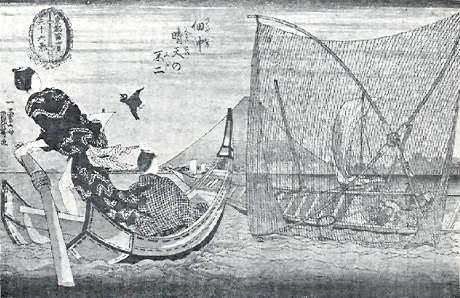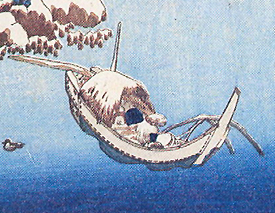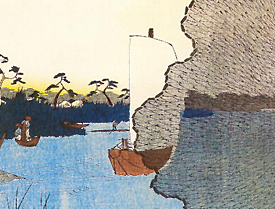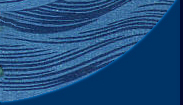
Time
7 May 2007
By Michelle Damian
Too much time has elapsed since my last entry. I'd originally planned to try to update every two weeks, and here it is over a month later. This too is part of writing a thesis, I suppose: the rest of my life getting in the way! A class presentation here, conference there, and other readings and papers due at the end of the semester (can't ignore those other classes) took over for a while. I finally turned in all of my papers last Friday to finish off the spring semester, and now can turn my attention back to the thesis proper. I also need to say a belated thank you again to everyone who has emailed me recently with additional information. As always, I am very much in everyone's debt for pointing me in new directions.
Fortunately I haven't had to put everything entirely on the back burner. The final paper for one of my classes had to be on maritime material culture, a fairly wide field that included representations of maritime culture... like woodblock prints! I had planned on including a chapter on maritime culture as seen through the prints in my thesis anyway, so this served as a preliminary discussion of the results and has been a kickstart to me to actually begin writing.

Kuniyoshi's Fuji Viewed from the Coast of Tsukuda. The yotsude-ami being pulled from the water. From Sadao Kikuchi, A Treasury of Japanese Wood Block Prints Ukiyo-E. Trans. Don Kenny. Crown Publishers, Inc., New York. 1968
Although the maritime culture paper was helpful to begin integrating my readings, my observations while in Japan, and the prints themselves, it was somewhat frustrating in that there is so much information and not enough time to delve deeply into it all. I settled for concentrating on prints showing fishing scenes, cargo vessels and shipping, ferryboats, pleasure boats, and religious scenes. Each of these is broken down even further: fishing in lakes, rivers, and the open water; pleasure boats for flower viewing, amorous assignations, or gathering to watch fireworks, and the like. In doing that, though, I cut out topics such as reuse of vessels, laborers, myths and actors depicted... the list could go on. There's a thesis worth of material on the cultural landscape alone, without ever getting into the ship construction.

Detail of Hokusai's Sumida River. Note the X shape of the yotsude-ami resting in the water. From Matthi Forrer, Hokusai Prints and Drawings. Prestel, Munich. 1991.
It was interesting to examine details to see any commonalities in the scenes that the artists depicted. Looking closely at the river fishing scenes, I found that nine of the ten scenes that I had gathered show nets in use, with two-thirds of those showing the yotsude-ami, the four-armed net. Apparently able to be operated by a single person, this was a simple contraption consisting of a net with corners tied to an X-shaped crosspiece formed by two long pieces of bamboo. The net was lowered into the river and pulled up to ensnare a swimming school of fish. Several prints depict the yotsude-ami either being pulled up or simply at rest in the river. I have yet to find much written on the various river fishing techniques of the Tokugawa era, but looking at these prints it seems that net fishing was a popular method.

Detail of Hiroshige's Scattered Pines on the Bank of the Tonegawa. The fine lines of the netting are one way to display artistic prowess. From Mikhail Uspensky, Hiroshige: A Hundred Views of Edo. Barnes & Noble Books, New York. 2005.
Then again, I have to keep in mind that these are artistic representations. Technological innovations in woodblock prints in the late eighteenth century allowed multiple blocks to be pressed on the same sheet of paper, affording a greater versatility in depicting color and apparent layering of materials.1 Using such fine lines and shadowing came to demonstrate the artistic prowess of both the painter and woodblock carvers. That skill is present in scenes such as Hiroshige's Scattered Pines on the Bank of the Tonegawa. The prominence of fishing nets may have been one medium to demonstrate that versatility in landscape prints. Even with that in mind, though, the number of prints simply hinting at the presence of the nets without actually showing the nets such as Hokusai's Sumida River, or depicting the nets as solid black tells me that the nets were indeed an important implement in fishing.
So with that paper, I've turned in (and am waiting for a critique on) what will hopefully be a thesis chapter. I gave myself the weekend off to recover from the end-of-semester craziness, and on Monday will start officially writing the rest of the thesis. I'm hoping to not leave a month between project journal entries anymore. It's time to start working in earnest.
As always please feel free to contact me at muaprojectjournal@yahoo.com with any comments, questions, or suggestions during the weeks to come. Yoroshiku onegai shimasu ("I look forward to your good favor").
________________
1 Akiyama, Terukazu. Japanese Painting. Rizzoli International Publications, Inc., New York. 1990. 171.
Return to Project Journal home page.

